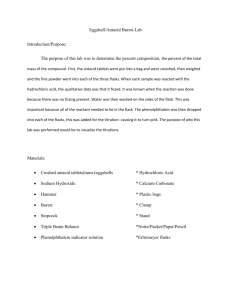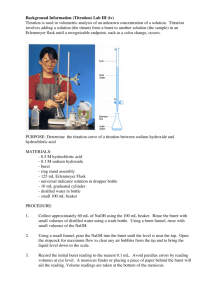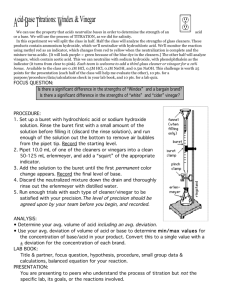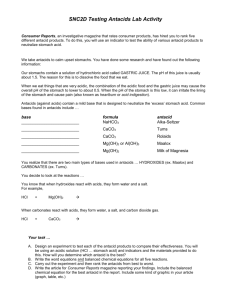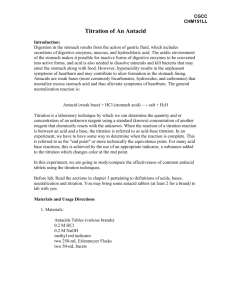4-5 Testing Antacids Lab fy11
advertisement
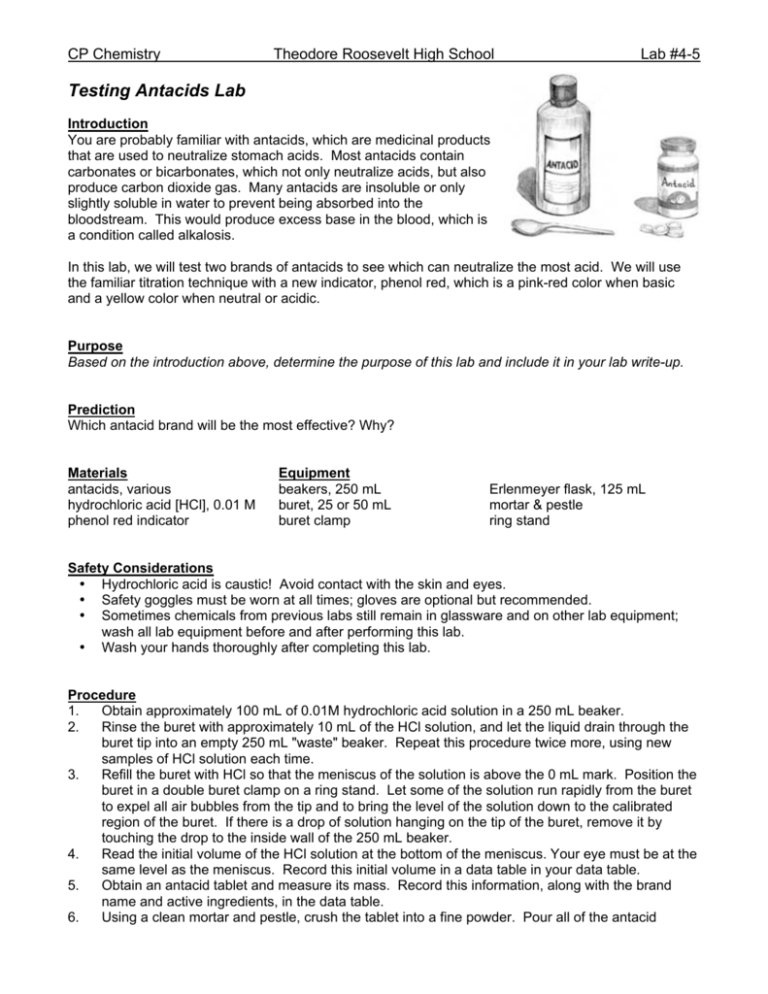
CP Chemistry Theodore Roosevelt High School Lab #4-5 Testing Antacids Lab Introduction You are probably familiar with antacids, which are medicinal products that are used to neutralize stomach acids. Most antacids contain carbonates or bicarbonates, which not only neutralize acids, but also produce carbon dioxide gas. Many antacids are insoluble or only slightly soluble in water to prevent being absorbed into the bloodstream. This would produce excess base in the blood, which is a condition called alkalosis. In this lab, we will test two brands of antacids to see which can neutralize the most acid. We will use the familiar titration technique with a new indicator, phenol red, which is a pink-red color when basic and a yellow color when neutral or acidic. Purpose Based on the introduction above, determine the purpose of this lab and include it in your lab write-up. Prediction Which antacid brand will be the most effective? Why? Materials antacids, various hydrochloric acid [HCl], 0.01 M phenol red indicator Equipment beakers, 250 mL buret, 25 or 50 mL buret clamp Erlenmeyer flask, 125 mL mortar & pestle ring stand Safety Considerations • Hydrochloric acid is caustic! Avoid contact with the skin and eyes. • Safety goggles must be worn at all times; gloves are optional but recommended. • Sometimes chemicals from previous labs still remain in glassware and on other lab equipment; wash all lab equipment before and after performing this lab. • Wash your hands thoroughly after completing this lab. Procedure 1. Obtain approximately 100 mL of 0.01M hydrochloric acid solution in a 250 mL beaker. 2. Rinse the buret with approximately 10 mL of the HCl solution, and let the liquid drain through the buret tip into an empty 250 mL "waste" beaker. Repeat this procedure twice more, using new samples of HCl solution each time. 3. Refill the buret with HCl so that the meniscus of the solution is above the 0 mL mark. Position the buret in a double buret clamp on a ring stand. Let some of the solution run rapidly from the buret to expel all air bubbles from the tip and to bring the level of the solution down to the calibrated region of the buret. If there is a drop of solution hanging on the tip of the buret, remove it by touching the drop to the inside wall of the 250 mL beaker. 4. Read the initial volume of the HCl solution at the bottom of the meniscus. Your eye must be at the same level as the meniscus. Record this initial volume in a data table in your data table. 5. Obtain an antacid tablet and measure its mass. Record this information, along with the brand name and active ingredients, in the data table. 6. Using a clean mortar and pestle, crush the tablet into a fine powder. Pour all of the antacid CP Chemistry 7. 8. 9. 10. Theodore Roosevelt High School Lab #4-5 powder into a clean 125 mL Erlenmeyer flask. Add 20.0 mL of distilled water to the Erlenmeyer flask. Swirl the flask for thirty seconds to try to dissolve as much of the antacid as possible. Add four drops of phenol red indicator to the flask. Place the Erlenmeyer flask under the tip of the base buret. While continuously swirling the flask to ensure thorough mixing, run in the HCl solution from the buret. As the endpoint nears, the color will change more slowly. Eventually, the HCl should be added drop by drop until one drop changes the color of the entire solution in the flask. This new color should remain for at least 15 seconds while the solution is being swirled. If you overshoot the endpoint, you will have to discard the solution and begin again. When you have reached a satisfactory endpoint, read the final volume of the buret. Record the final volume in the data table. Clean your Erlenmeyer flask and repeat steps #3-9 for two additional brands of antacid tablets. Additional Clean-up and Disposal 1. Drain your buret into the waste beaker and rinse it with tap water. 2. Wash any remaining solutions and materials down the sink. Data – you should create a data table in your lab write-up that looks something like this: Antacid Mass Initial HCl Titrated Amount Total Tums Rolaids Calculations (Include these answers in your Conclusion!) 1. Using your data, determine which antacid is more effective at neutralizing acid per tablet. 2. Using your data, determine which antacid is more effective at neutralizing acid per gram. Questions 1. What advantage does phenol red have over phenolphthalein in this lab? 2. Does it matter how much distilled water you add to the antacid powder? Why or why not? 3. What difference is there between the active ingredients of the antacids? What effect, if any, do you believe this has on their ability to neutralize acid? Errors Describe two possible errors you may have committed in this lab that may have somehow affected your results. Explain the specific steps you will take to avoid each of these errors in the future. Conclusion Write two or more paragraphs summarizing your results, examining the validity of your prediction, and explaining your calculations. CP Chemistry Theodore Roosevelt High School Testing Antacids Lab workspace: Lab #4-5

